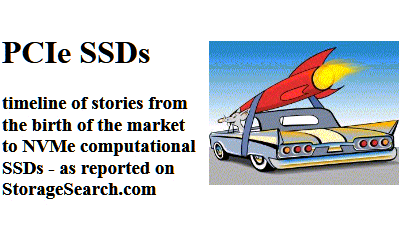|
|
|
|
|
|
SSD news - February 2013This page includes the archived SSD news from StorageSearch.com for the above period.Companies mentioned on this page in stories include:- Crocus Technology, Everspin Technologies, Fusion-io, HGST, Hyperstone, InnoDisk , Intel, LSI, Micron, Nexenta Systems, NEVEX, OCZ, PLX Technology, Proton Digital Systems, Pure Storage, Samsung, SanDisk, Seagate, Silicon Motion, Skyera, SMART, Sonnet Technologies, STEC, Violin, ViON, Virident Systems, WhipTail, |
| . |
| Violin migrates controller
implementations to eASIC Editor:- February 27, 2013 - Violin has selected ASICs from eASIC's Nextreme-2T range to replace high density FPGAs and implement fast flash controller functions more efficiently within its 6000 series SSD rackmounts it was announced today. "There is tremendous innovation going on in the enterprise storage market and we are thrilled to be working with Violin, one of the fastest growing leaders in this space," said Ronnie Vasishta, President and CEO, eASIC. "OEMs need to continuously innovate and quickly ramp to volume production. We are starting to see a tipping point where FPGAs cannot be used in mission critical, power sensitive, volume applications and the ASIC alternatives do not meet the requirements. Traditional cell-based ASICs just take too long to design and ASSPs have limited flexibility for the NAND FLASH interface." another $24 million funding for ZFS SSD ASAP ISV Nexenta Editor:- February 27, 2013 - Nexenta Systems today announced it has secured $24 million in Series D financing. The company's SSD ASAP software - called NexentaStor - currently supports SSDs from the following companies:- DDRdrive, HGST, InnoDisk , Intel, LSI, OCZ, SanDisk, Seagate, SMART and STEC - according to Nexenta's hardware support list (pdf). Micron enters SAS SSD market Editor:- February 26, 2013 - Micron today became the 19th company to enter the SAS SSD market. The company today announced production of its new P410m SSD - a 2.5" SSD with R/W speeds upto 410MB/s and 345MB/s respectively and 50K/30K R/W IOPS for the 400GB model which uses 25nm MLC. Endurance is 10 drive fills per day for 5 years. Editor's comments:- Micron is currently the only company manufacturing both PCIe and SAS compatible enterprise SSDs in the 2.5" form factor. See also:- memory channel SSDs Everspin quadruples MRAM chip R/W Editor:- February 26, 2013 - Everspin Technologies today announced it will sample the first of a new family of MRAM chips in Q2. The MR10Q010 (1Mb in a 16 pin SOIC) has a quad SPI serial interface instead of the single line interface offered in earlier MRAM devices. This makes it more attractive for applications which need the simplicity of no wear-out non volatile memory and fast write performance in low capacity and small footprint applications. Skyera gets $51 million from Dell Editor:- February 21, 2013 - Skyera today announced it has closed $51.6 million in financing led by Dell Ventures. Skyera will use the money to accelerate its integration of the latest-generation flash technology and also to drive broader market adoption of its adaptive R/W based, big controller architecture, efficient, Skyhawk family of rackmount SSDs. "The investment in Skyera is one example of how we are deploying our Fluid Data Storage Fund to target areas critical to the evolution of storage..."said Jim Lussier, Managing Director of Dell Ventures. See also:- VCs in SSDs, exciting new directions in rackmount SSDs Silicon Motion's new mobile devices TLC SSD controller Editor:- February 21, 2013 - Silicon Motion announced imminent sampling of a new SSD controller - for consumer handheld products. The SM2703 is a single-channel, SD 3.0 UHS-I (Ultra High Speed Phase I) card controller with superior support for the vast majority of NAND flash, including 2y-nm, 1x-nm and 1y-nm TLC and MLC which delivers up to 95MB/s and enables full HD video recording capability by digital cameras, smartphones and other mobile devices on both Class 4 and Class 6 SD flash memory cards using cost-effective TLC NAND flash. "We've already had tremendous success in the UHS-I market since we introduced our first UHS-I controller 2 years ago - which was used by most of the world's leading flash card brands" said Wallace Kou, President and CEO of Silicon Motion. "Our solution was widely adopted because it was high performance, cost-effective, and supported the vast majority of available NAND components. Our new 55nm based SM2703 controller is firmware compatible and is a cost-effective, flexible quick way to market for customers who want to use the latest MLC and TLC NAND flash." WhipTail outgrows in-house manufacturing Editor:- February 21, 2013 - WhipTail today announced that it has outsourced manufacturing its full range of rackmount SSDs to NEI. "When we were a small company, we could handle our own manufacturing, but that's not the case anymore" said Dan Crain, CEO WhipTail. Crocus steers R&D efforts to simplify and accelerate adoption of magnetically enhanced semiconductors Editor:- February 21, 2013 - Crocus Technology today announced the appointment of Dr. Ken Mackay as VP of technology development in which role he will manage and overview nano-magnetic materials research and CMOS teams - within the company and in partner organizations - towards the goal of fully integrating Crocus' magnetically enhanced semiconductor technology to the needs of industrial markets. Virident betas remote PCIe SSD sharing Editor:- February 21, 2013 - Virident Systems recently announced beta availability of a new software suite - called FlashMAX Connect - which enables low latency shared server-side storage and high availability when used with the company's range of PCIe SSDs. New functionality includes:-
Editor's comments:- it's long been known within the SSD industry that these features have been in the pipeline - because they're based on support at the PCIe switch chip level. For an overview of this architecture enabling chip level support and how it offers flexibility in servers and SSDs - take a look at this video - PCIe in enterprise SSD designs by PLX. |
| . |
 |
| . |
|
|
updated SSD controller line from Hyperstone Editor:- February 21, 2013 - Hyperstone is presenting their updated line-up of low power consumption high reliability NAND Flash controllers at the Embedded World trade show next week in Nuremberg, Germany. PernixData announces Flash Virtualization Platform Editor:- February 20, 2013 - "PernixData has done for server flash what VMware did for CPU and memory" - said Poojan Kumar, CEO and co-founder of PernixData - at the launch of the company's Flash Virtualization Platform today as the company exited stealth mode. PernixData says it's working with a select number of companies as part of its early access program. new report on embedded flash drives market Editor:- February 20, 2013 - Web-Feet Research expects revenue in the embedded flash drive market to reach $15 billion in 2017 - "driven heavily by mobile handsets, tablets, portable media players, digital camcorders, GPS, digital radio along with the adoption of flash cache in notebook and desktop PCs." In this context EFDs and cards are defined as sub-systems of solid state storage ranked below SSD. The company recently published a new report Embedded Flash Drives, eMMC and emNAND: 2010-2017 (134 pages, $5.5K) which includes forecasts for EFD applications and related markets. OCZ's SATA SSDs advance to 20nm Editor:- February 19, 2013 - OCZ today announced imminent availability of 20nm flash technology 2.5" SATA SSDs - based on LSI's SandForce SF-2200 SSD controllers - as extensions to OCZ's popular Vertex 3 SSD Series. SSD Review exposes how rebranded memory can adulterate consumer SSDs Editor:- February 18, 2013 - the SSD Review recently published an in-depth article which shows how the memory chips in consumer SSDs - which appear to come from one source - may actually have come from somewhere else. The article - by Les Tokar, Editor-in-Chief of the SSD Review - reads at times like a gripping detective story - and looks into the murky topic of remarking and rebranding flash chips - which can lead to adulteration and quality problems in the memory supply chain - all in pursuit of getting the lowest manufacturing cost. These problems and risks have been well known in expert SSD circles but Les Tokar's new exposé brings this shadow world into vivid focus. ...read the article See also:- my (2009 article) - Why can consumers expect to see more flaky flash SSDs?, WARNING! - CONSUMER SSD - contents liable to change without notice 2017 could be 1st billion dollar year for non-flash nvm Editor:- February 18, 2013 - Yole Developments recently published a new market report - Emerging Non-Volatile Memories (5,990 euros) which describes why and how emerging alternative NVM (FRAM, MRAM/STTMRAM, PCM, RRAM) could grow from $209 million revenue in 2012 to $2 billion in 2018. Among other things - the report says 3D RRAM could start to be used in SSDs in 2017-2018, when 3D NAND's scalability prospects are anticipated to worsen. Steve Picot joins ViON as VP of Federal Sales Editor:- February 18, 2013 - ViON today announced that Steve Picot has recently joined the company as VP Federal Sales. Sonnet launches bootable PCIe SSD for desktops Editor:- February 13, 2013 - Sonnet Technologies today launched a bootable PCIe SSD aimed at PCs and MACs. The Tempo PCIe SSD product is a nearly fast enough base card onto which users can install standard 2.5" SATA SSDs. Another reason to look again at Intel SSDs Editor:- February 13, 2013 - Intel yesterday announced that in the next 30 days it will ship a Linux version of the SSD caching software - based on IP from its acquisition of NEVEX last August. The products have been rebranded as Intel® CAS (Cache Acceleration Software). Editor's comments:- I would categorize Intel's current generation of enterprise SSD solutions (which includes the same old indifferent SSDs working with the new CAS software) as being in the medium to fast-enough performance range. Suitable customers might be end users who have never used SSD acceleration before - or users with apps which don't need the higher speeds offered by competing SSD bundled drive / module packages from Fusion-io, SanDisk and OCZ - and customers who don't want to do their caching via dedicated rackmount based products from the dozens of other vendors listed in the SSD ASAPs directory. The market segment addressed by these new Intel products is the early majority of enterprise SSD adopters - who will be reassured by the perceived safety of buying into the dangerous world of solid state storage acceleration from a value based brand. I spoke about the new CAS software to Intel product manager Andrew Flint who cofounded NEVEX and I learned some useful things about the product. The first question I asked was - how many PCIe SSDs can the CAS product support in a single server? And were there any graphs showing how performance drops off or is maintained when you do that. The answer was - this info isn't publicly available right now. Although it may be in the future. That's when I concluded that Intel CAS (married to current generation Intel SSDs) isn't a fast product - and is not in the kind of performance league where a user would seriously worry about this type of scalability problem. Intel's ideal end-user customers right now for CAS are people who have been using no SSD acceleration at all coupled with hard drive arrays. That performance silo could change - with faster Intel SSDs in the future - and isn't due to limiting characteristics in the software. I asked - Does it support 3rd party SSDs? I was told - the standard release only supports Intel SSDs. But there's nothing in principle to prevent it being used with other SSDs using the open source release of the software. The product is a read cache. I was told that it makes very good use of whatever RAM is in the server to optimize both read and write performance. However, my view is that as Intel SSDs aren't fast - this is somewhat academic. I asked about the time constants which are analyzed by the caching software - and learned that - depending on the app - the data usage period which is analyzed goes up to days. (Generally in this type of product longer is better - and when you go up from milli-seconds and seconds to minutes, hours and days - you have the potential to get better caching results.) I learned that Intel CAS isn't written around the data structure or interface - and is hardware agnostic. Users can tell the software which apps they want to cache - via a control panel. This is very useful in environments where a single server is running a mix of apps - some of which are critical (in performance needs) while others are not. I asked - does the CAS have to have advance knowledge of the app? - Is it optimized for a preset list of apps? I was told - No. It will work just as well for - what I called - dark matter software- which might be a proprietary app which no one else knew about. I asked if Intel collects stats from the general population of installed servers which use the software? - in order to improve tuning algorithms... I was told - No. The optimizations (data eviction probability rates) are done based on what is learned on the customer's own server and private data - and the factory shipped software. There isn't a wider intelligence learning or gathering or snooping function. I learned that a special feature of this Intel CAS release is the ability to share cache resources with a remote SSD. The data stays hot and doesn't have to be recreated when different virtual machines are accessing this type of resource. Overall I came away with a good impression of the CAS software and how well the NEVEX technology idea has been assimilated into Intel's SSD business. It will undoubtedly help Intel sell more SSDs to people who have never used enterprise SSDs before - and maybe also to people with low end apps who have used SSD acceleration before but whose first choice of SSDs wouldn't otherwise have been Intel. See also:- SSD software, SSD ASAPs, the case for auto-caching SSDs STEC resists pressure to replace board Editor:- February 12, 2013 - STEC's management team has responded to the demands of a special interest group of shareholders' who want to replace the entire board of 7 directors. STEC's CEO offered to interview 4 of the shareholder nominated replacements and offer 2 up for election. Can you trust SSD market data? Editor:- February 12, 2013 - StorageSearch.com today published a new SSD home page blog - Can you trust SSD market data? Can you trust market reports and the handed down wisdom from analysts, bloggers and so-called "industry experts" any more than you can trust SSD benchmarks to tell you which product is best? ...read the article Proton gets funds to rejuvenate flash Editor:- February 7, 2013 - Proton Digital Systems today announced the completion of its $2 million seed round to support continued development and expansion of its LDPC-based flash read channel IP products that increase the endurance and longevity of flash memory. Proton's IP is currently licensed for enterprise and consumer applications and has already been adopted by some of the world's largest flash memory companies. See also:- adaptive R/W and DSP IP in SSDs, SSD controllers, how to market flash management care schemes for SSDs aligning database block sizes with SSDs Editor:- February 5, 2013 - I often hear from readers designing software for SSDs who - having researched the subject of flash etc - have spent too much time over-worrying about internal SSD hardware details that they really shouldn't be worrying about. Because by the time they learn about such things - that type of hardware anxiety is ancient history. Today I came across a recent blog by Chas. Dye at Pure Storage called Please DON'T Fiddle with Your Database Block Size! - which also warns about this very issue. Chas says - "At Pure Storage, we believe that a factor that should never influence the block size decision is your storage subsystem." Editor's comments:- I'd certainly agree that trying to slavishly make your data structures look like something you've read about which might be inside an SSD controller is probably a waste of time - because unless you know the SSD designer you don't really know what's going on - and the abstraction you read about in some web site is only a small part of the picture. If an SSD is so sensitive to the data you hit it with - it's not the SSD you should have bought in the first place. Samsung allocates $1 billion to clarify visibility in big data Editor:- February 4, 2013 - Samsung today announced it has allocated over $1 billion to invest in big data related business ventures. Editor's comments:- to you and me - $1 billion sounds like a lot of money - but for Samsung? - really it's small change. From my past conversations with people in the company who think about acquisitions and strategic stuff - I'm left with the impression of a company which invests a lot of talent trying to understand what's going on out there and to analyze what macro market factors and changes will impact its semiconductor fabs. Samsung was actually the first multi-billion dollar scale company to publicly recognize the strategic importance of the SSD market (2005). But replacing past memory business with new SSD business for many years was a problem on the scale of bailing out water from the Titanic with bathtub size pots. Like other big interested entities - Samsung could do little more than satisfice its engagements in SSD while waiting for the whole SSD market to get bigger, and the trends to get clearer. Along the way it has invested in some SSD IP companies - such as Fusion-io, acquired others like NVELO, and tried but failed to acquire SanDisk (2008). Rather than simply being seen as traditional return on investments - this type of activity by Samsung and other semico companies like Intel - is a way of ensuring strategic forward visibility into new seedlings in the ecosystems which surround their core businesses. PCIe everywhere? Editor:- February 1, 2013 - Is PCIe the Natural Next-Generation Data Center Fabric? That's what Larry Chisvin, VP of strategic initiatives PLX Technology believes and he'll try to convert you to his way of thinking next week at the Linley Tech Data Center Conference in Santa Clara. PLX is the worldwide market leader in PCIe switch products. See also:- enterprise SSD silos, PCIe SSDs, SSD glue chips. |
| . |
 | ||||||
| .. | ||||||
 | ||||||
1.0" SSDs 1.8" SSDs 2.5" SSDs 3.5" SSDs 19" rack SSDs | ||||||
| ..... | ||||||
 | ||||||
| . | ||||||
| ||||||
| ..... | ||||||
| ||||||
| ..... | ||||||
| ||||||
..... | ||||||
 | ||||||
..... | ||||||
| ||||||
..... | ||||||
 | ||||||
. . | ||||||
 |







